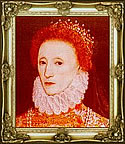
![]() lizabeth
Tudor was born in 1533. Her father was Henry VIII and her mother Anne
Boleyn. This was Henry's second marriage. He had first been married to
a Spanish princess called Catherine of Aragon. The marriage was a reasonably
happy one but Henry became increasingly frustrated by Catherine's inability
to provide him with a son and heir; their only child was a daughter, Mary
Tudor.
lizabeth
Tudor was born in 1533. Her father was Henry VIII and her mother Anne
Boleyn. This was Henry's second marriage. He had first been married to
a Spanish princess called Catherine of Aragon. The marriage was a reasonably
happy one but Henry became increasingly frustrated by Catherine's inability
to provide him with a son and heir; their only child was a daughter, Mary
Tudor.
In 1527, when Henry was still married to Catherine, he met and fell in love Anne Boleyn. Convinced that Anne could provide him with the boy he wanted, Henry, a devout Catholic, sought the permission of the Pope to divorce Catherine. Henry was reluctant to defy the Pope, but Anne's pregnancy forced his hand. In 1533, he decided to break away from the Roman Catholic Church and declared himself Head of the new Church of England. This enabled Henry to declare his first marriage illegal and marry Anne Boleyn.
To Henry's disappointment, the child born on 7th September 1533 was another girl, named Elizabeth after Henry's mother. Two years later, Anne Boleyn was accused of being unfaithful to Henry and of plotting against him. She was tried and executed in 1536. In the following year, Henry's third wife, Jane Seymour gave birth to the son, the future Edward VI. Henry now had the heir he so desperately wanted.
From 1543, Elizabeth and her younger half-brother Edward came increasingly under the influence of Henry's sixth wife, Catherine Parr. Catherine was a Protestant and saw that both Elizabeth and Edward were brought up as Protestants. Elizabeth was intelligent and highly educated. She could speak Greek, Latin, French and Italian and was particularly fond of music.
Elizabeth's father died in 1547 and the new king was Edward VI, her half-brother. Edward reigned for only six years and died in 1553 when he was only fifteen years old. Elizabeth's elder half-sister, Mary I, succeeded him and Elizabeth herself was now heir to the throne. During Edward's reign, England had become a fully Protestant country, but Mary, who had never lost her Catholic faith, made England a Roman Catholic country again and announced plans to marry Philip of Spain, soon to be the most powerful Catholic ruler in Europe.
These changes were unpopular with many Englishmen, who preferred the Protestant Elizabeth to the Catholic Mary. One of these, Sir Thomas Wyatt, led a rebellion in protest against the Spanish marriage. Wyatt came very close to success but was eventually defeated. Elizabeth was suspected of being involved in the rebellion and was arrested and placed in the Tower. The penalty for treason was execution, but there was not enough evidence to convict her and she was released but carefully guarded. Memory of this experience may have influenced Elizabeth's later treatment of Mary Queen of Scots.
In November 1558, Mary died and Elizabeth became Queen of England at the age of twenty five. She would rule England for forty five years, but this must have looked unlikely in 1558. Although she was popular, few of her subjects were confident that a woman could be a successful ruler. Meanwhile, her position was seriously threatened by Mary Queen of Scots - now Queen of both Scotland and France. In the eyes of Catholic Europe, Elizabeth was illegitimate and Mary Queen of Scots was the rightful Queen of England.
The way in which Elizabeth dealt with the threat of Mary Queen of Scots is the subject of this program.